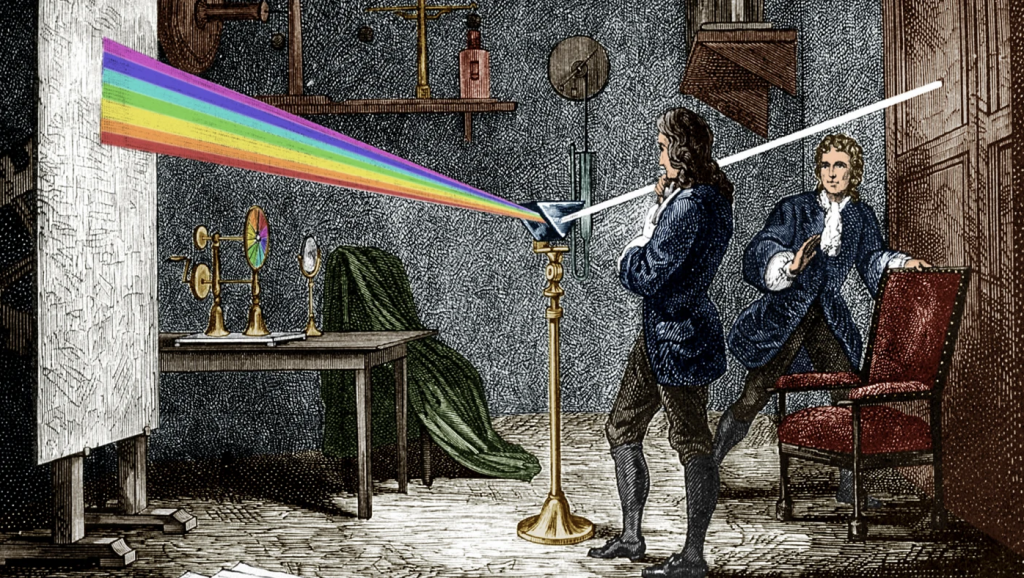Scientific Revolution + Baroque
1600 – 1700
This century brought about revolutionary scientific ideas by Newton in England. This was also the time when the Baroque style flourished under the use of Bernini in Italy.
In Britiain
Science + Tools
Newton and his productive pandemic
Isaac Newton had to leave Cambridge University to return back to his home in Lincolnshire during the plague year of 1665-66. In this isolated time (much like we’re going through now), he made three great discoveries (along with many more).
- Gravity – Watching an apple fall to the ground from the tree outside his bedroom window in his countryside home made him question why it fell straight to the ground.
- White light is made up of all the colours (eventually led to the fundamentals of physical optics) – He drilled a hole in the shutter of his bedroom window and held a prism up to the beam of sunlight that came through it to make the discovery
- Calculus – He finally had the time to contemplate complex mathematical questions that he had began to think about while he was at Cambridge, and out of the year, he wrote three papers on fluxions (early calculus)

https://www.gettyimages.ca/photos/isaac-newton-prism?mediatype=photography&phrase=isaac%20newton%20prism&sort=mostpopular
Meanwhile in Italy
Architecture
Baroque Brilliance
This period was also the time when the Baroque style flourished. Baroque architecture was mainly characterized by complex shapes, extravagant ornaments, its movement, and theatrical drama.
One of the leading figures of Baroque architecture was Gian Lorenzo Bernini. He was an Italian architect, sculptor, and painter known for his work on the interior and exterior of St. Peter’s Basilica redesign in Vatican City. From from 1656-67, his was the sole architect of Piazza San Pietro outside of the basilica and it was a full display of his brilliance working with optical illusions and spatial ordering. Bernini’s main objective was to fully interpret the great meaning of the basilica and provide a sacred area where the faithful could come and be protected from the harsh outside world and feel like they’re being welcomed by the pope and surrounded by the arms of “maternal arms of Mother Church”.

https://ezproxy.capilanou.ca/login?url=https://search.credoreference.com/content/entry/bridgeart/bird_s_eye_view_of_st_peter_s_basilica_and_piazza_form_the_views_of_rome_series_c_1760_etching/0?institutionId=6884

https://commons.wikimedia.org/wiki/File:St._Peter%27s_Baldachin_by_Bernini.jpg
(Offside: I visited Vatican City in 2012 when I was just a teenager touring with my high school orchestra, but I had no background knowledge on any of the architecture at the time. While I remember being impressed at how beautiful everything was, I wish I knew then what I’m learning now about the genius and creativity behind the architecture! But then again, this place was designed to be experienced by a naive visitor who would not have known all the work that went behind it.)
References
“Newton, Sir Isaac.” Britannica Concise Encyclopedia, Encyclopaedia Britannica, Britannica Digital Learning, 2017. Credo Reference, https://ezproxy.capilanou.ca/login?url=https://search.credoreference.com/content/entry/ebconcise/newton_sir_isaac/0?institutionId=6884. Accessed 14 Oct. 2020.
“Newton, Sir Isaac (1642 – 1727).” The Cambridge Dictionary of Scientists, edited by David Millar, Cambridge University Press, 2nd edition, 2002. Credo Reference, https://ezproxy.capilanou.ca/login?url=https://search.credoreference.com/content/entry/dicscientist/newton_sir_isaac_1642_1727/0?institutionId=6884. Accessed 14 Oct. 2020.
“Baroque.” Bloomsbury Guide to Human Thought, edited by Kenneth McLeish, Bloomsbury, 1st edition, 1993. Credo Reference, https://ezproxy.capilanou.ca/login?url=https://search.credoreference.com/content/entry/bght/baroque/0?institutionId=6884. Accessed 14 Oct. 2020.
Kurian, George Thomas. “Bernini, Gianlorenzo (1598-1680).” The Encyclopedia of Christian Civilization, George Thomas Kurian, Wiley, 1st edition, 2012. Credo Reference, https://ezproxy.capilanou.ca/login?url=https://search.credoreference.com/content/entry/wileyenchci/bernini_gianlorenzo_1598_1680/0?institutionId=6884. Accessed 14 Oct. 2020.